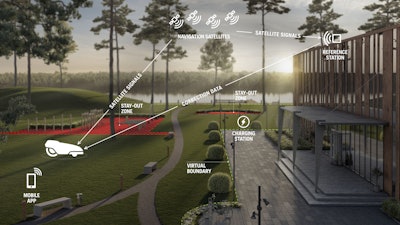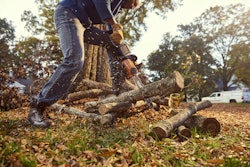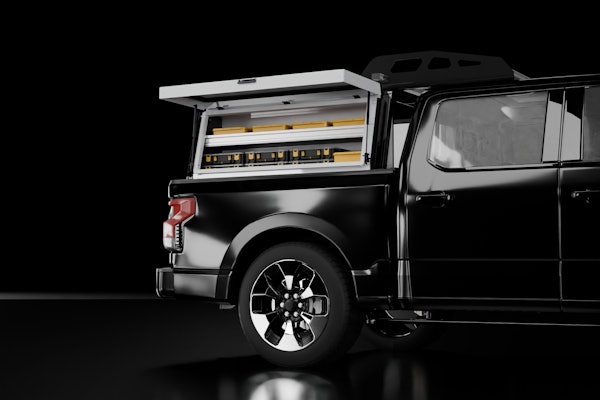 Photo: Husqvarna
Photo: HusqvarnaHusqvarna has been leading the charge with robotic mowers since 1995 and it continues to innovate and improve its Automower technology.
One innovation that was announced at the 2019 GIE+EXPO was the creation of its EPOS technology, which allows for mowing with virtual boundaries. According to Husqvarna, it has an accuracy up 1.18 inches.
Steven Uljua, Husqvarna’s product manager for robotics in North America, says in its simplest form, EPOS eliminates the need for guide wires in the ground. It uses real-time kinematic (RTK) positioning, which is a satellite navigation technique to determine a precise location. Using satellite positioning, the technology will triangulate with a reference station on the property to determine where the mower should be.
While GPS technology has been available to the public for a number of years now, the accuracy for a car is much less precise than what is needed for a robotic mower. While 10 to 15 feet accuracy in vehicle is perfectly acceptable, Uljua explains this lack of precision with a robotic mower could easily result in a homeowner losing some rose bushes.
Uljua says Husqvarna has been working on developing this technology for years.
“With everything, we’re always looking forward and even way back when, we knew that (we had to figure out) how do we get rid of the wires, because the wire in the ground is a limitation for more than just installation,” he says.
The government dictates how much signal you can push through a wire, thus limiting how big of an area the wires can be installed.
“In installation, we tell people, say an acre and quarter on our bigger machines, it really is about how much signal we can push through that wire,” he says. “The machine is capable of more.”
With the virtual boundaries, landscapes with islands and other challenges to wires are no longer an issue. It also makes it easier to make changes to a yard without disrupting the machine’s ability to mow. Uljua says this is the next step in robotics.
Uljua says the virtual boundaries will change the installation process slightly but it will still take about four hours to get the system set up.
Eliminating the guide wires solves the issue found with fall aeration, where sometimes landscape professionals end up cutting a wire if they didn’t mark it or were unaware the wire was there. Also, with the virtual boundaries, landscapers are able to divide the property into zones, so the mower can be told not to mow the front yard, but it will still be able to mow the back and side yard.
To set up the system is called ‘walking the dog,’ where the landscaper uses the app on their phone and walks the mower to the green sections.
“I’m going to use the app that says every day mow sections one, two, and three,” Uljua says. “It’s going to go into that section, mow, make a beeline to section two, mow, make a beeline to section three, mow, and it’s not going to waste its time mowing the sidewalk or just kind of randomly trying to find these areas. You’re going to tell it through the app.”
With the app, users can also draw lines, move the wires and create invisible islands. Uljua says landscapers could even use the Automower to mow four different houses close to each other, thanks to the different zones, with all the landscaper having to do is pick up the mower and set it at the next house on the route.
“Now I can have one machine mowing multiple properties within reason, as long as they’re say 500 meters apart,” Uljua says. “It’s still going to get signal from that one device in the yard that sends a signal, but allows the opportunity to do different things virtually.”
As for the cost, Uljua says while the EPOS technology will cost a little more, when you factor in the cost of wire installation it will be about the same price.
There is currently no plan to phase out the guide wires but Uljua doesn’t want to say never.
“Because as this technology gets cheaper, then obviously it would definitely be worth phasing it out, but currently right now because the cost of the technology, all the wireless technologies, it’s still cheaper to put a wire in the ground.”
EPOS is being tested out by select professional customers in the U.S, France, Germany and Sweden in 2020.
Currently, Husqvarna is looking for a customer base that is familiar with the technology and already has guide wires installed on properties so they can compare apples to apples.
The EPOS frequency being used in the rest of the world is the U.S.’s military signal, so naturally Husqvarna is changing the signal for the U.S.
After thorough beta testing, Uljua expects Husqvarna will launch this technology in the fall of 2020, probably around the time for the next GIE+EXPO.
“I want to get some good testing underneath our belt,” Uljua says. “We want to get some good feedback from the field. I want to thoroughly make sure that this fits the U.S. market.”









